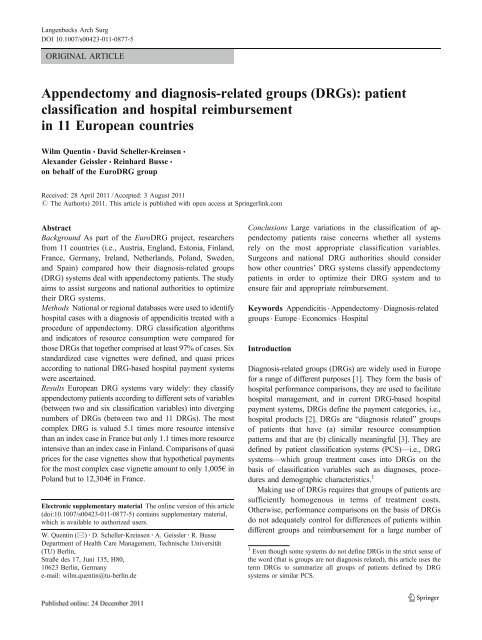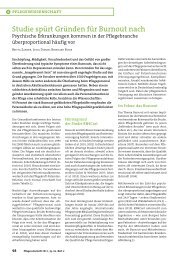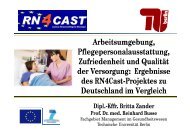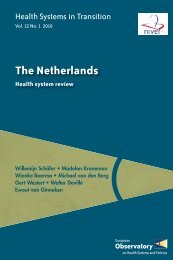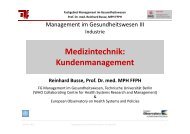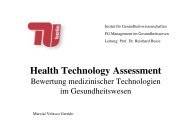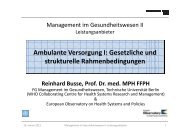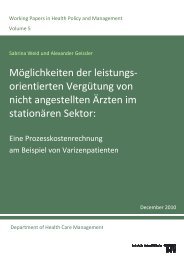Appendectomy and diagnosis-related groups (DRGs ... - TU Berlin
Appendectomy and diagnosis-related groups (DRGs ... - TU Berlin
Appendectomy and diagnosis-related groups (DRGs ... - TU Berlin
You also want an ePaper? Increase the reach of your titles
YUMPU automatically turns print PDFs into web optimized ePapers that Google loves.
Langenbecks Arch Surg<br />
DOI 10.1007/s00423-011-0877-5<br />
ORIGINAL ARTICLE<br />
<strong>Appendectomy</strong> <strong>and</strong> <strong>diagnosis</strong>-<strong>related</strong> <strong>groups</strong> (<strong>DRGs</strong>): patient<br />
classification <strong>and</strong> hospital reimbursement<br />
in 11 European countries<br />
Wilm Quentin & David Scheller-Kreinsen &<br />
Alex<strong>and</strong>er Geissler & Reinhard Busse &<br />
on behalf of the EuroDRG group<br />
Received: 28 April 2011 /Accepted: 3 August 2011<br />
# The Author(s) 2011. This article is published with open access at Springerlink.com<br />
Abstract<br />
Background As part of the EuroDRG project, researchers<br />
from 11 countries (i.e., Austria, Engl<strong>and</strong>, Estonia, Finl<strong>and</strong>,<br />
France, Germany, Irel<strong>and</strong>, Netherl<strong>and</strong>s, Pol<strong>and</strong>, Sweden,<br />
<strong>and</strong> Spain) compared how their <strong>diagnosis</strong>-<strong>related</strong> <strong>groups</strong><br />
(DRG) systems deal with appendectomy patients. The study<br />
aims to assist surgeons <strong>and</strong> national authorities to optimize<br />
their DRG systems.<br />
Methods National or regional databases were used to identify<br />
hospital cases with a <strong>diagnosis</strong> of appendicitis treated with a<br />
procedure of appendectomy. DRG classification algorithms<br />
<strong>and</strong> indicators of resource consumption were compared for<br />
those <strong>DRGs</strong> that together comprised at least 97% of cases. Six<br />
st<strong>and</strong>ardized case vignettes were defined, <strong>and</strong> quasi prices<br />
according to national DRG-based hospital payment systems<br />
were ascertained.<br />
Results European DRG systems vary widely: they classify<br />
appendectomy patients according to different sets of variables<br />
(between two <strong>and</strong> six classification variables) into diverging<br />
numbers of <strong>DRGs</strong> (between two <strong>and</strong> 11 <strong>DRGs</strong>). The most<br />
complex DRG is valued 5.1 times more resource intensive<br />
than an index case in France but only 1.1 times more resource<br />
intensive than an index case in Finl<strong>and</strong>. Comparisons of quasi<br />
prices for the case vignettes show that hypothetical payments<br />
for the most complex case vignette amount to only 1,005€ in<br />
Pol<strong>and</strong> but to 12,304€ in France.<br />
Electronic supplementary material The online version of this article<br />
(doi:10.1007/s00423-011-0877-5) contains supplementary material,<br />
which is available to authorized users.<br />
W. Quentin (*) : D. Scheller-Kreinsen : A. Geissler : R. Busse<br />
Department of Health Care Management, Technische Universität<br />
(<strong>TU</strong>) <strong>Berlin</strong>,<br />
Straße des 17, Juni 135, H80,<br />
10623 <strong>Berlin</strong>, Germany<br />
e-mail: wilm.quentin@tu-berlin.de<br />
Conclusions Large variations in the classification of appendectomy<br />
patients raise concerns whether all systems<br />
rely on the most appropriate classification variables.<br />
Surgeons <strong>and</strong> national DRG authorities should consider<br />
how other countries’ DRG systems classify appendectomy<br />
patients in order to optimize their DRG system <strong>and</strong> to<br />
ensure fair <strong>and</strong> appropriate reimbursement.<br />
Keywords Appendicitis . <strong>Appendectomy</strong>. Diagnosis-<strong>related</strong><br />
<strong>groups</strong> . Europe . Economics . Hospital<br />
Introduction<br />
Diagnosis-<strong>related</strong> <strong>groups</strong> (<strong>DRGs</strong>) are widely used in Europe<br />
for a range of different purposes [1]. They form the basis of<br />
hospital performance comparisons, they are used to facilitate<br />
hospital management, <strong>and</strong> in current DRG-based hospital<br />
payment systems, <strong>DRGs</strong> define the payment categories, i.e.,<br />
hospital products [2]. <strong>DRGs</strong> are “<strong>diagnosis</strong> <strong>related</strong>” <strong>groups</strong><br />
of patients that have (a) similar resource consumption<br />
patterns <strong>and</strong> that are (b) clinically meaningful [3]. They are<br />
defined by patient classification systems (PCS)—i.e., DRG<br />
systems—which group treatment cases into <strong>DRGs</strong> on the<br />
basis of classification variables such as diagnoses, procedures<br />
<strong>and</strong> demographic characteristics. 1<br />
Making use of <strong>DRGs</strong> requires that <strong>groups</strong> of patients are<br />
sufficiently homogenous in terms of treatment costs.<br />
Otherwise, performance comparisons on the basis of <strong>DRGs</strong><br />
do not adequately control for differences of patients within<br />
different <strong>groups</strong> <strong>and</strong> reimbursement for a large number of<br />
1 Even though some systems do not define <strong>DRGs</strong> in the strict sense of<br />
the word (that is <strong>groups</strong> are not <strong>diagnosis</strong> <strong>related</strong>), this article uses the<br />
term <strong>DRGs</strong> to summarize all <strong>groups</strong> of patients defined by DRG<br />
systems or similar PCS.
patients is not appropriate; it can be either too high or too low.<br />
In order to assure homogenous <strong>groups</strong> of patients, DRG<br />
systems need to consider the most important determinants of<br />
resource consumption as classification variables. In many<br />
countries, professional medical associations, specialist<br />
experts, or consultants formally participate in the process of<br />
selection, definition, <strong>and</strong> update of classification criteria via<br />
committees, expert hearings, or consultations [4–6]. It is,<br />
therefore, of utmost importance for specialist <strong>groups</strong> such as<br />
surgeons that they are aware of how their respective patients<br />
are classified by their DRG system in order to assess whether<br />
the classification variables adequately reflect differences in<br />
the complexity of treating different <strong>groups</strong> of patients using<br />
different techniques.<br />
Comparative analyses of how countries’ DRG systems<br />
classify patients can help surgeons to scrutinize national<br />
st<strong>and</strong>ards of classification against European equivalents in<br />
order to identify potential scope for improvement. Furthermore,<br />
analyses of how the services of surgeons in treating<br />
different patients are valued <strong>and</strong> reimbursed in other DRG<br />
systems may inform <strong>and</strong> substantiate discussions about the<br />
adequacy of cost weights (or other indicators of resource<br />
consumption). Yet, detailed comparative analyses of classification<br />
algorithms for appendectomy are very scarce, suffer<br />
from a very limited scope, <strong>and</strong> have not assessed the<br />
classification of patients using routine inpatient data [7, 8].<br />
This study therefore performs a comprehensive assessment<br />
of DRG systems across 11 European countries <strong>and</strong> has three<br />
main objectives: (1) to assess classification variables <strong>and</strong><br />
algorithms used to group patients with appendectomy into<br />
<strong>DRGs</strong>, (2) to compare the composition of these <strong>DRGs</strong> <strong>and</strong><br />
variations in relative resource intensity, <strong>and</strong> (3) to determine<br />
<strong>DRGs</strong> <strong>and</strong> hospital price levels for six case vignettes of<br />
appendectomy patients with different combinations of demographic,<br />
diagnostic, <strong>and</strong> treatment variables.<br />
The results were generated in the framework of the<br />
EuroDRG project, 2 which selected 10 episodes of care to<br />
assess European DRG systems <strong>and</strong> their ability to define<br />
homogenous <strong>groups</strong> of patients. In this article, we focus on<br />
appendectomy as it is one of the most common emergency<br />
surgical procedures in high-income countries [9–12].<br />
Materials <strong>and</strong> methods<br />
Definition of episode of care <strong>and</strong> appendectomy index case<br />
As part of the EuroDRG project, researchers from 11<br />
European countries (i.e., Austria, Engl<strong>and</strong>, Estonia,<br />
2 Diagnosis-<strong>related</strong> <strong>groups</strong> in Europe: Towards Efficiency <strong>and</strong> Quality<br />
(EuroDRG) funded under the seventh framework programme (FP7) of<br />
the European Commission; www.eurodrg.eu.<br />
Finl<strong>and</strong>, France, Germany, Irel<strong>and</strong>, the Netherl<strong>and</strong>s,<br />
Pol<strong>and</strong>, Sweden, <strong>and</strong> Spain) agreed upon a common<br />
definition for an appendectomy episode of care (EoC).<br />
The definition was based on the 2007 version of the<br />
International Classification of Diseases 10th edition<br />
(ICD-10) for diagnoses <strong>and</strong> the 2008 version of the<br />
ICD-9 Clinical Modification for procedures <strong>and</strong> is<br />
presented in Table 1. Researchers from each country<br />
translated the definition into national codes for diagnoses<br />
<strong>and</strong> procedures considering available mappings from the<br />
Hospital Data Project if applicable [13].<br />
An appendectomy index case was defined (i.e., adult<br />
age, uncomplicated appendicitis without complications,<br />
open appendectomy, treated as inpatient) to facilitate<br />
comparisons of relative resource intensity of <strong>DRGs</strong> within<br />
countries (see below).<br />
Data sources<br />
In each country, researchers identified national or regional<br />
hospital databases <strong>and</strong> obtained access to all information<br />
necessary for the purposes of this study. Table 2 provides<br />
an overview to the databases <strong>and</strong> data years available for<br />
each country. Databases were required to contain information<br />
about diagnoses, procedures, <strong>and</strong> <strong>DRGs</strong> of individual<br />
patients in order to make possible identification of<br />
appendectomy patients conforming to the agreed definition.<br />
Analysis of patient classification systems<br />
The number of appendectomy EoC cases <strong>and</strong> the<br />
corresponding <strong>DRGs</strong> were extracted from the databases for<br />
each country. Detailed comparative analyses of classification<br />
variables <strong>and</strong> grouping algorithms of national DRG systems<br />
Table 1 Definition of episode of care <strong>and</strong> reference case<br />
Definition<br />
Langenbecks Arch Surg<br />
Name <strong>Appendectomy</strong><br />
Defined by Primary <strong>diagnosis</strong> <strong>and</strong> procedure<br />
Primary <strong>diagnosis</strong><br />
(ICD-10-WHO V2007) a<br />
K35: Acute appendicitis<br />
K36: Other appendicitis<br />
K37: Unspecified appendicitis<br />
K38: Other diseases of appendix<br />
Procedure<br />
47.0: <strong>Appendectomy</strong>, including<br />
(ICD-9CM V2008) 47.01: Laparoscopic appendectomy<br />
47.09: Other appendectomy<br />
Index case<br />
Adult age (
Langenbecks Arch Surg<br />
Table 2 Data years <strong>and</strong><br />
databases by country Country Data year Source of data<br />
[14–22] were performed for those most frequent <strong>DRGs</strong> that<br />
together comprised a cumulative percentage of at least 97%<br />
of all appendectomy EoC cases. All <strong>DRGs</strong> originating from<br />
an included base DRG were included in the analyses.<br />
Grouping algorithms were mapped graphically to facilitate<br />
easy comparison of differences <strong>and</strong> similarities between<br />
systems. In addition, the percentage of all appendectomy<br />
EoC cases grouped into the DRG <strong>and</strong> the percentage of all<br />
cases within each DRG conforming to the definition of<br />
appendectomy was calculated.<br />
In order to compare relative resource intensity of <strong>DRGs</strong><br />
within each country, a DRG cost index was calculated with<br />
the index case assuming a value of 1. The value of all other<br />
<strong>DRGs</strong> was calculated by dividing the national measure of<br />
resource consumption (i.e., cost weight, score, average<br />
tariff) of each DRG by that of the index DRG.<br />
<strong>DRGs</strong> <strong>and</strong> hospital quasi prices<br />
Six st<strong>and</strong>ardized case vignettes of patients with different<br />
combinations of primary <strong>and</strong> secondary diagnoses, procedures,<br />
age, <strong>and</strong> length of stay were defined (Table 3). This<br />
selection is meant to cover a range of different <strong>DRGs</strong> in<br />
different countries’ systems. Case vignettes 1, 2, <strong>and</strong> 3<br />
represent rather complicated cases of appendicitis, while the<br />
remaining ones are less complicated cases.<br />
DRG-based hospital payment systems differ between <strong>and</strong><br />
often even within countries [23], thus, complicating comparisons<br />
across countries. Therefore, quasi prices were ascertained<br />
for each case vignette <strong>and</strong> for the index case using an<br />
approach similar to that of Koechlin et al. [8]. Quasi prices<br />
were calculated by converting national measures of resource<br />
consumption (i.e., cost weights, average tariffs, scores) into<br />
Austria 2008 Leistungsorientierte Krankenanstaltenfinanzierung (LKF)<br />
database of the Bundesministerium für Gesundheit (BMG)<br />
Engl<strong>and</strong> 2007/08 Hospital Episode Statistic (HES)<br />
Estonia 2008 Estonian Health Insurance Fund (EHIF) database<br />
Finl<strong>and</strong> 2008 Finnish Hospital Discharge Register<br />
France 2008 Programme de Médicalisation des Systèmes d’Information<br />
en Médecine, Chirurgie, Obstétrique (PMSI MCO)<br />
Germany 2008 Fallpauschalenbezogene Krankenhausstatistik (DRG-statistic)<br />
of the Federal Statistical Office (Destatis)<br />
Irel<strong>and</strong> 2008 Hospital In-patient Enquirey (HIPE) data base of the Health<br />
Services Executive (HSE)<br />
Netherl<strong>and</strong>s 2008 Diagnose Beh<strong>and</strong>eling Combinaties (DBC) Onderhoud database<br />
Pol<strong>and</strong> 2009 Register of episodes of care <strong>and</strong> reimbursements of the<br />
National Health Fund (NHF)<br />
Sweden 2008 The National Patient register (NPR) of The Board of Health <strong>and</strong> Welfare<br />
Spain (Catalonia) 2008 Hospital Minimum Basic Data Set (CMBD) database of the<br />
Public Hospital Network of Catalonia (XHUP)<br />
monetary values using national conversion rates that were<br />
supposed to reflect the national average costs of treatment<br />
<strong>and</strong>—if possible—to include the full set of costs, i.e.,<br />
recurrent <strong>and</strong> capital costs. If necessary, prices were deflated<br />
to year 2008 national currency using national gross domestic<br />
product (GDP) deflators [24] <strong>and</strong> converted to Euros using<br />
average currency exchange rates for the year 2008 [25].<br />
Results<br />
Figure 1 provides a graphic illustration of grouping algorithms<br />
<strong>and</strong> classification variables of PCS in 11 European<br />
countries. The figure includes classification variables of those<br />
<strong>DRGs</strong> that together account for more than 97% of appendectomy<br />
cases in each country. On the left h<strong>and</strong> side, the figure<br />
specifies for each country the version of the PCS <strong>and</strong> the<br />
percentage of all appendectomy cases shown in the graph. The<br />
arrows indicate the sequence in which different types of<br />
classification variables are considered in the grouping<br />
algorithm. In addition, indicators to assess the composition<br />
of <strong>DRGs</strong> <strong>and</strong> the relative resource intensity of cases within<br />
each DRG are shown. Finl<strong>and</strong> <strong>and</strong> Sweden are shown together<br />
with only one grouping algorithm as both use the NordDRG<br />
system which is identical for the presented <strong>DRGs</strong>.<br />
Patient classification of appendectomy cases in Europe<br />
Overview: number of <strong>DRGs</strong> <strong>and</strong> number of classification<br />
variables<br />
The figure demonstrates that there is great variation in DRG<br />
systems across Europe. The number of <strong>DRGs</strong> comprising
Table 3 Case vignettes: Patient classification variables<br />
Primary <strong>diagnosis</strong> a Secondary diagnoses b <strong>Appendectomy</strong> procedure Age (years) Setting Death during admission LOS (days)<br />
Patient 1 K35.0 No Open 8 Inpatient No 6<br />
Patient 2 K35.0 E11.8, I42.0, I69.3 Open 85 Inpatient Yes 9<br />
Patient 3 K35.1 T81.3, T81.4 Open 35 Inpatient No 16<br />
Patient 4 K35.9 No Open 10 Inpatient No 2<br />
Patient 5 K37 No Laparoscopic 12 Inpatient No 4<br />
Patient 6 K38.8 No Laparoscopic 14 Outpatient No 0<br />
more than 97% of cases differs considerably in different<br />
countries’ systems. In Irel<strong>and</strong>, appendectomy cases are<br />
classified into only two <strong>DRGs</strong>, while in Germany 11 <strong>DRGs</strong><br />
exist to account among other things for different levels of<br />
complexity <strong>and</strong> different age <strong>groups</strong>.<br />
In addition, the number of classification variables differs:<br />
the Austrian system differentiates only between different<br />
age <strong>groups</strong>, when classifying appendectomy patients; the<br />
French system differentiates (1) primary diagnoses, (2)<br />
level of complications or comorbidities (CC), (3) age<br />
<strong>groups</strong>, (4) with or without death during admission, <strong>and</strong><br />
(5) length of stay.<br />
Characteristics of classification variables<br />
Different DRG systems classify appendectomy patients on<br />
the basis of different classification variables. There are<br />
three main <strong>groups</strong> of classification variables: (1) treatment<br />
characteristics, (2) patient characteristics, <strong>and</strong> (3) provider/<br />
setting characteristics. Only the first two are considered in<br />
most DRG systems.<br />
In all systems, treatment characteristics, i.e., the<br />
procedure of appendectomy dominates the grouping<br />
algorithm <strong>and</strong> is always considered prior to the specific<br />
primary <strong>diagnosis</strong> except in the Dutch Diagnose<br />
Beh<strong>and</strong>eling Combinaties (DBC) system. Only the All-<br />
Patient (AP)-DRG system in use in Spain <strong>and</strong> the Dutch<br />
DBC system differentiate between laparoscopic <strong>and</strong><br />
open appendectomy. In the German (G)-DRG system<br />
<strong>and</strong> the AP-DRG system, a small number of patients is<br />
classified on the basis of other small intestinal/digestive<br />
system surgical procedures. The length of stay (LOS) is<br />
considered only in the French system.<br />
A maximum of four patient characteristics are considered<br />
in the grouping process. In seven countries, the DRG<br />
systems differentiate between patients with a primary<br />
<strong>diagnosis</strong> for complicated appendicitis (i.e., appendicitis<br />
Langenbecks Arch Surg<br />
a<br />
Based on ICD-10-WHO V2007: K35.0 acute appendicitis with generalized peritonitis; K35.1 acute appendicitis with peritoneal abscess; K35.9<br />
acute appendicitis, unspecified; K37 unspecified appendicitis; K38.8 other specified diseases of appendix; a full list of relevant ICD-10 codes is<br />
provided as online material<br />
b<br />
Based on ICD-10-WHO V2007: E11.8 non-insulin-dependent diabetes mellitus with unspecified complications; I42.0 dilated cardiomyopathy;<br />
I69.3 sequelae of cerebral infarction; T81.3 disruption of operation wound, not elsewhere classified; T81.4 infection following a procedure, not<br />
elsewhere classified<br />
with generalized peritonitis or peritoneal abscess, each<br />
defined by specific ICD-10 codes), <strong>and</strong> those without. In<br />
most countries, the presence of relevant secondary diagnoses,<br />
i.e., complications <strong>and</strong> CC, also influences the<br />
classification of patients. However, while some countries’<br />
systems only differentiate between with <strong>and</strong> without CC,<br />
others define several levels of CC (e.g., major CC in the<br />
AP-DRG system or level one to four CC in the French<br />
system), <strong>and</strong> again other systems calculate cumulative<br />
patient clinical complexity levels. Furthermore, age plays<br />
an important role in the classification process of several<br />
systems (i.e., Austria, Engl<strong>and</strong>, France, <strong>and</strong> Germany).<br />
Interestingly, the French system differentiates between<br />
elderly (i.e., above 80 years) <strong>and</strong> others, whereas the<br />
German system differentiates between children (i.e., below<br />
10 or below 15 years) <strong>and</strong> others. Death is considered a<br />
classification variable only in the French Groupes Homogènes<br />
de Malades (GHM) system.<br />
Provider <strong>and</strong> setting characteristics are considered only<br />
in the Finnish <strong>and</strong> Swedish versions of Nord<strong>DRGs</strong> <strong>and</strong> in<br />
the Dutch DBC system. In these systems, the grouping<br />
process differentiates between cases treated in inpatient <strong>and</strong><br />
outpatient settings (not shown in the case of the Netherl<strong>and</strong>s,<br />
where only very few cases are concerned). In<br />
addition, the Dutch DBC system considers provider<br />
characteristics by determining the department, where<br />
patients are treated (i.e., surgery).<br />
Composition of <strong>DRGs</strong> <strong>and</strong> variation in relative resource<br />
intensity<br />
In most countries, the vast majority of appendectomy EoC<br />
cases are grouped into the shadowed DRG (in Fig. 1)<br />
containing the index case (see Table 1), i.e., between 55%<br />
in Germany <strong>and</strong> 92% in Irel<strong>and</strong>. Finl<strong>and</strong> is the only<br />
country, where 56% of patients are classified into a DRG<br />
containing appendectomy cases with generalized peritonitis
Langenbecks Arch Surg<br />
Fig. 1 Graphic illustration of grouping algorithms <strong>and</strong> classification variables of PCS in 11 European countries<br />
or peritoneal abscess or patients with other complications<br />
<strong>and</strong> comorbidities. Within these index <strong>DRGs</strong>, almost all<br />
patients conform to our EoC definition (i.e., around 90% or<br />
above—shown in the second to last column). Only in<br />
Austria, the index DRG includes about 25% of patients that<br />
do not have a <strong>diagnosis</strong> of appendicitis. This might be<br />
explained by the fact that the <strong>diagnosis</strong> is not part of the<br />
Austrian grouping algorithm.
Fig. 1 (continued)<br />
The cost index shows that the index DRG is the<br />
lowest-valued DRG in all countries except in Finl<strong>and</strong><br />
<strong>and</strong> Sweden, where separate “outpatient” DRG cost<br />
weights exist that are about 20% lower than the index<br />
DRG in Finl<strong>and</strong> <strong>and</strong> 55% lower than the index DRG in<br />
Sweden. In general, in DRG systems with only two or<br />
three <strong>DRGs</strong> for appendectomy patients (i.e., in Austria,<br />
Engl<strong>and</strong>, Finl<strong>and</strong>, Sweden, Irel<strong>and</strong>, the Netherl<strong>and</strong>s, <strong>and</strong><br />
Pol<strong>and</strong>), even the highest-valued DRG has a cost index<br />
below 2, implying that the systems do not adequately<br />
account for cases that are more than twice as complex<br />
as the index case. In Spain (Catalonia, AP-DRG V23),<br />
the most complex DRG containing more than 3% of patients<br />
<strong>and</strong> accounting for major complications such as chronic heart<br />
failure or pneumonia has a cost index of 4.75. In France, the<br />
most complex DRG (patients with complicated appendicitis,<br />
level 4 CC or level 3 CC <strong>and</strong> age greater than 80 years, <strong>and</strong> a<br />
LOS longer than 5 days) is valued more than five times as high<br />
as the index case.<br />
In DRG systems where age is considered in the<br />
classification process, hospitals generally receive higher<br />
payments for elderly patients <strong>and</strong> for children. The differences<br />
can be quite large: For example, in Austria patients<br />
above age 69 have a cost index of more than 1.6. However,<br />
the difference between children <strong>and</strong> adults is relatively<br />
small in Engl<strong>and</strong> <strong>and</strong> Germany. In the AP-DRG system <strong>and</strong><br />
Langenbecks Arch Surg<br />
the Dutch DBC system, the only two systems that<br />
differentiate between open <strong>and</strong> laparoscopic appendectomy,<br />
hospitals receive higher payments for laparoscopic appendectomy<br />
than for open appendectomy. The difference<br />
between open <strong>and</strong> laparoscopic appendectomy is relatively<br />
small in Spain but amounts to 17% in the Netherl<strong>and</strong>s.<br />
In countries differentiating between complicated <strong>and</strong><br />
uncomplicated appendicitis as primary <strong>diagnosis</strong>, the cost<br />
index is considerably higher for complicated appendicitis.<br />
In all countries except for Finl<strong>and</strong>, the cost index is at least<br />
1.4 for complicated appendicitis cases. Only in Finl<strong>and</strong>,<br />
where almost all patients are classified as complicated<br />
appendicitis, the cost index is around 1.1.<br />
<strong>DRGs</strong> <strong>and</strong> hospital quasi prices for case vignettes<br />
Table 4 shows a comparison of <strong>DRGs</strong> <strong>and</strong> hospital quasi<br />
prices reflecting national average hospital payments for<br />
each case vignette under the assumption that hospital<br />
payment would be exclusively based on <strong>DRGs</strong>. For each<br />
case vignette, the first column specifies the DRG into<br />
which a case vignette patient would be classified <strong>and</strong><br />
whether he would be considered an inlier or an outlier, i.e.,<br />
whether the predefined length of stay is below or above the<br />
DRG system-specific lower or upper length of stay<br />
threshold. The second column specifies for each patient
Langenbecks Arch Surg<br />
Table 4 Comparison of hospital (quasi) prices for appendectomy patients in Europe (in year 2008 Euros)<br />
Patient 1 Patient 2 Patient 3 Patient 4 Patient 5 Patient 6 Index case<br />
(Shadow)<br />
Price<br />
(Euros)<br />
DRG (in-/<br />
outlier)<br />
(Shadow)<br />
Price<br />
(Euros)<br />
DRG (in-/<br />
outlier)<br />
(Shadow)<br />
Price<br />
(Euros)<br />
DRG (in-/<br />
outlier)<br />
(Shadow)<br />
Price<br />
(Euros)<br />
DRG (in-/<br />
outlier)<br />
(Shadow)<br />
Price<br />
(Euros)<br />
DRG (in-/<br />
outlier)<br />
(Shadow)<br />
Price<br />
(Euros)<br />
DRG (in-/<br />
outlier)<br />
(Shadow)<br />
Price<br />
(Euros)<br />
DRG (in-/<br />
outlier)<br />
MEL06.01B 2.273 € MEL06.01A 3.049 € MEL06.01C 2.089 € MEL06.01B 1.864 € MEL06.01B 2.273 € MEL06.01B 1.045 € MEL06.01C 1.877 €<br />
(inlier)<br />
(inlier)<br />
(outlier)<br />
(outlier)<br />
(inlier)<br />
(day case)<br />
Engl<strong>and</strong> b<br />
F82 (inlier) 2.852 € F81 (inlier) 3.572 € F81 (outlier) 3.852 € F82 (inlier) 2.852 € F82 (inlier) 2.852 € F82 (inlier) 2.852 € FZ20B 2.657 €<br />
(day case)<br />
Estonia c<br />
165 (inlier) 860 € 164 (inlier) 1.323 € 164 (inlier) 1.323 € 167 (inlier) 562 € 167 (inlier) 562 € 167 (inlier) 562 € 167 562 €<br />
Finl<strong>and</strong> d<br />
166N (inlier) 4.254 € 166N (inlier) 4.254 € 166N (inlier) 4.254 € 167 (inlier) 3.822 € 167 (inlier) 3.822 € 167O 3.144 € 167 3.822 €<br />
France e<br />
06C081 (inlier) 3.283 € 06C082 (inlier) 4.841 € 06C084 (inlier) 12.304 € 06C091 (inlier) 2.400 € 06C091 (inlier) 2.400 € Not classifiable – 06C091 2.400 €<br />
Germany f<br />
G22A (inlier) 3.467 € G07C (inlier) 3.700 € G07C (inlier) 3.700 € G23B (inlier) 2.111 € G23B (inlier) 2.111 € Not classifiable – G23C 1.990 €<br />
Irel<strong>and</strong> g<br />
G07B (inlier) 4.645 € G07A (inlier) 8.768 € G07A (inlier) 8.768 € G07B (inlier) 4.645 € G07B (inlier) 4.645 € Not classifiable G07B 4.645 €<br />
Netherl<strong>and</strong>s 0303.11.113.203 3.058 € 0303.11.113.203 3.058 € 0303.11.113.203 3.058 € 0303.11.113.203 3.058 € 0303.11.113.303 3.585 € 0303.11.113.301 1.422 € 0303.11. 3.058 €<br />
113.203<br />
Pol<strong>and</strong> F82 (inlier) 1.005 € F82 (inlier) 1.005 € F82 (inlier) 1.005 € F83 (inlier) 685 € F83 (inlier) 685 € F83 (inlier) 685 € F83 685 €<br />
Spain h<br />
165 4.359 € 553 12.563 € 164 7.311 € 167 2.657 € 883 2.822 € 883 2.822 € 167 2.657 €<br />
Sweden 166N (inlier) 5.009 € 166N (inlier) 5.009 € 166N (inlier) 5.009 € 167 (inlier) 3.499 € 167 (inlier) 3.499 € 167O 1.528 € 167 3.499 €<br />
Austria a<br />
a<br />
Reported values are based on theoretically calculated scores. Actual hospital reimbursement depends on decisions of states, which make use of nationwide DRG scores in different ways. Patient 6<br />
has a length of stay=0 but would NOT be considered an outpatient<br />
b<br />
Based on 2008/9 tariff prices <strong>and</strong> HRG version 3.5. All relevant to-ups are included in the shown tariff. HRG 4 reimbursements could not be determined. Reported figures are reimbursements for<br />
emergency admissions. Elective admissions receive a different tariff. Patient 6 has a length of stay=0, but would NOT be classified as an outpatient<br />
c<br />
Shadow prices were calculated by multiplying cost weights with the national base rates. In actual reimbursement, hospitals are paid through a mix of DRG based reimbursement <strong>and</strong> fee-forservice.<br />
The actual DRG based reimbursement is only 70% of the reported shadow price with the remaining 30% being <strong>related</strong> to fee-for-service payments<br />
d<br />
Actual reimbursement varies by type of hospital (i.e., university, central, local hospitals) <strong>and</strong> hospital district. Provided figures are volume weighted averages across all hospitals. Outlier limits<br />
differ between hospital districts. In some hospital districts, patient 3 might be considered an outlier. In this case certain surcharges based on per diems might be applied<br />
e Reported prices are for public sector hospitals since private hospital prices do not reflect full costs<br />
f Calculated using national DRG cost weights <strong>and</strong> the average of state-wide base rates<br />
g<br />
Calculated using AR-DRG V 5.1 <strong>and</strong> the national average inpatient ‘base price’ of €5,219 for a relative value of 1 <strong>and</strong> the other casemix parameters (including low <strong>and</strong> high length of stay trim<br />
points) from the 2009 inpatient casemix model (used to estimate the 2010 casemix budgetary adjustments on the basis of 2008 activity <strong>and</strong> cost data)<br />
h<br />
AP-<strong>DRGs</strong> in Spain are used when patients receive care in non-resident autonomous communities (ACs). The price shown in the last column is the rate that would be paid for these patients,<br />
calculated by multiplying national Spanish cost weights with the national base rate. The payment to hospitals for all other patients depends on the hospital payment system in the relevant<br />
autonomous community. When using AP-<strong>DRGs</strong> in Spain, inliers/outliers are not determined
the corresponding quasi price. In the last column of the<br />
table, the index <strong>DRGs</strong> (see Fig. 1) <strong>and</strong> corresponding quasi<br />
prices are presented.<br />
Apparently, large variation in hospital payments exists<br />
across countries. In general, costs appear to be lower in<br />
countries with a low GDP per capital [24], i.e., Estonia <strong>and</strong><br />
Pol<strong>and</strong>, <strong>and</strong> high in countries with a higher GDP (even<br />
though exceptions exist). Interestingly, however, countries<br />
that pay a higher price for one patient do not necessarily<br />
pay a higher price for all kinds of patients. For example,<br />
hospitals in France would receive much higher payments<br />
for appendectomy performed on a young patient, with<br />
peritoneal abscess, wound infection disruption of the<br />
operation wound <strong>and</strong> a long length of stay (patient 3) than<br />
hospitals in Engl<strong>and</strong>. However, hospitals in Engl<strong>and</strong> would<br />
receive higher payments for performing appendectomy on a<br />
young patient with no secondary diagnoses <strong>and</strong> a short<br />
length of stay (patient 4) than hospitals in France.<br />
Discussion<br />
This study presents results of the most comprehensive<br />
available comparative analysis of grouping algorithms,<br />
classification variables, <strong>and</strong> prices used for appendectomy<br />
patients in different DRG systems in Europe. It shows great<br />
variations across countries: (1) in the number of <strong>DRGs</strong><br />
comprising more than 97% of appendectomy cases <strong>and</strong> in<br />
the number of considered classification variables; (2) in the<br />
characteristics of classification variables that take account<br />
of treatment, patient, <strong>and</strong> provider/setting characteristics;<br />
(3) in the degree of differentiation between complex <strong>and</strong><br />
less complex cases, i.e., in the relative resource intensity of<br />
different <strong>DRGs</strong>; <strong>and</strong> (4) in quasi prices for different types<br />
of patients (case vignettes).<br />
As <strong>DRGs</strong> are used to assess the performance of hospitals<br />
(including that of surgeons) <strong>and</strong> to determine hospital<br />
payment [1, 2], it is important that DRG systems consider<br />
the most appropriate classification variables <strong>and</strong> define as<br />
many <strong>groups</strong> as necessary to assure that performance<br />
comparisons <strong>and</strong> hospital payments are fair [26]. Given<br />
the identified large variations between DRG systems in<br />
different countries for the classification of a relatively welldefined<br />
group of patients, it is at least questionable whether<br />
all DRG systems consider as classification variables the<br />
most important determinants of resource consumption<br />
within their country of use. Surgeons can influence<br />
decisions about how to define classification variables in<br />
their roles as advisors to national authorities responsible for<br />
defining <strong>and</strong> updating the patient classification systems of<br />
their countries [4–6]. International comparisons can provide<br />
a useful new perspective when thinking about how to<br />
improve an existing DRG system. However, before drawing<br />
Langenbecks Arch Surg<br />
conclusions on the basis of this study’s findings, limitations<br />
of our data <strong>and</strong> methodology need to be considered.<br />
Firstly, the data that was used to identify patients <strong>and</strong> to<br />
assess the relative importance of different <strong>DRGs</strong> in different<br />
countries, originated from routine inpatient databases in 11<br />
countries. As highlighted by the Hospital Data Project [13],<br />
there are differences in coding practices across countries,<br />
<strong>and</strong> the quality of data is not always comparable. One<br />
surprising finding of our study was that the majority of<br />
patients in Finl<strong>and</strong> were coded as having appendicitis with<br />
generalized peritonitis or peritoneal abscesses or other<br />
complications <strong>and</strong> CC, whereas in all other countries, this<br />
percentage was well below 30%. We do not know whether<br />
this represents inappropriate coding or late presentation of<br />
appendectomy patients in Finl<strong>and</strong>. However, both would be<br />
reasons for concern. As the data analyzed in this study is<br />
used to determine DRG-based payments, it is possible that<br />
some patients were inappropriately coded in order to<br />
maximize hospital revenues (“up-coding”) [27, 28].<br />
Secondly, differences in hospital payment systems<br />
between countries complicate comparative analyses of<br />
payment levels (Table 4). On the one h<strong>and</strong>, different<br />
countries set DRG-based payment rates at different levels<br />
as they include different cost categories. For example, in<br />
Germany, fixed capital costs are not included in DRG-based<br />
payment rates, whereas in most other countries, DRG-based<br />
payment rates are supposed to cover capital costs [8]. On<br />
the other h<strong>and</strong>, different systems of additional payments<br />
exist, e.g., Engl<strong>and</strong> assigns additional HRGs for certain<br />
diagnostic evaluations such as CT scans [29], <strong>and</strong> Pol<strong>and</strong><br />
<strong>and</strong> Austria have additional per diem-based payments for<br />
stays in intensive care units. Furthermore, the Netherl<strong>and</strong>s,<br />
Finl<strong>and</strong>, <strong>and</strong>—prior to HRG4—also Engl<strong>and</strong> could have<br />
several <strong>DRGs</strong> per hospital stay, each leading to additional<br />
DRG-based payments. Last but not least, DRG-based<br />
payments are adjusted in several countries to account for<br />
differences between hospitals or regions. Therefore, the<br />
absolute price levels should not be directly interpreted as<br />
reflecting more expensive care in one country compared to<br />
another. However, relative price levels within countries that<br />
were used for comparisons in Fig. 1 should be less affected<br />
by differences in payment systems as they were always<br />
compared to the in-country DRG index case.<br />
Thirdly, while our comparison has shown that<br />
classification of appendectomy patients <strong>and</strong> DRG-based<br />
hospital payment for these patients vary markedly across<br />
countries, we have not looked at the regular changes<br />
that take place between different versions of the same<br />
DRG system over time. Kobel et al. [30] haveshown<br />
that the number of <strong>DRGs</strong> has considerably increased in<br />
almost all DRG systems (except for the Dutch DBC<br />
system) between 2004 <strong>and</strong> 2010, from well below 1,000<br />
<strong>DRGs</strong> in 2004 to 1,200 <strong>DRGs</strong> <strong>and</strong> more in three systems
Langenbecks Arch Surg<br />
(i.e., G-DRG, 1,200; HRG, 1,389; GHM, 2,297). In<br />
addition, because our comparative assessment of classification<br />
variables has focused on the more frequent cases of<br />
appendectomy, including only 97% of cases in the most<br />
populated <strong>DRGs</strong>, we were unable to point out differences<br />
between systems in how they deal with rare high-cost<br />
cases, which, however, may be particularly relevant for<br />
reimbursement issues [31].<br />
In spite of these limitations, our study has major implications<br />
for surgeons <strong>and</strong> national authorities involved in the<br />
redesigning of national DRG systems. First, awareness about<br />
classification algorithms <strong>and</strong> variables in other countries<br />
should encourage surgeons to think about alternative <strong>and</strong><br />
possibly better ways to classify their patients into <strong>DRGs</strong>. For<br />
example, while seven countries differentiate between patients<br />
with a complicated primary <strong>diagnosis</strong> of appendicitis (i.e.,<br />
with generalized peritonitis or peritoneal abscess) <strong>and</strong> those<br />
without, four countries (Austria, Engl<strong>and</strong>, Irel<strong>and</strong>, <strong>and</strong> the<br />
Netherl<strong>and</strong>s) do not make this distinction. However, at least in<br />
Engl<strong>and</strong>, patients with a complicated primary <strong>diagnosis</strong> stay<br />
on average almost twice as long in hospital as those without<br />
(i.e., between 5.4 <strong>and</strong> 6.3 days versus about 3.0 days for most<br />
other cases [32]), suggesting that it would be worth testing<br />
whether homogeneity of patients within <strong>DRGs</strong> could be<br />
increased by introducing a classification variable for complicated<br />
primary diagnoses.<br />
Second, some DRG systems achieve a greater degree of<br />
differentiation between more <strong>and</strong> less complex patients than<br />
other countries as is reflected in the different range of the cost<br />
index in Fig. 1. If DRG systems do not adequately account<br />
for differences between patients, hospitals <strong>and</strong> surgeons that<br />
treat a greater share of more complex cases than others are<br />
not adequately paid for their greater efforts. Possibly, in<br />
countries with only few <strong>DRGs</strong> to account for differences in<br />
complexity, some of the differences in patient populations<br />
between hospitals are accounted for through adjustments<br />
outside of the DRG systems. For example in Irel<strong>and</strong> <strong>and</strong> in<br />
some states in Austria, hospital payments are adjusted for the<br />
type of hospital, e.g., teaching hospitals in Irel<strong>and</strong> receive<br />
higher payments [33]. However, ideally, differences in<br />
patient characteristics would be accounted for in the patient<br />
classification systems <strong>and</strong> not in the payment systems.<br />
Third, the aim of any DRG system is to give a concise<br />
measure of what hospitals do. This measure is useful only if<br />
<strong>DRGs</strong> describe a sufficiently homogenous group of patients<br />
[2]. Therefore, quantitative research is needed to verify<br />
whether the most important determinants of cost are<br />
considered in different patient classification systems, <strong>and</strong><br />
whether differences between systems reflect country specific<br />
differences in treatment patterns. The third phase of<br />
the EuroDRG project attempts to contribute to this<br />
discussion. However, it is also important for surgeons <strong>and</strong><br />
other medical specialists to be aware of the significance of<br />
adequately designed DRG systems <strong>and</strong> to engage in<br />
optimizing these systems. On the background of their<br />
clinical experience in treating patients, information presented<br />
in this article about how DRG systems classify<br />
appendectomy patients can help surgeons to engage with<br />
national DRG authorities. Ultimately, this contributes to<br />
assuring adequate reimbursement for treated patients <strong>and</strong><br />
fair performance comparisons on the basis of <strong>DRGs</strong>.<br />
Acknowledgment The findings <strong>and</strong> results presented in this article<br />
were generated in the framework of the project “Diagnosis-Related<br />
Groups in Europe: Towards Efficiency <strong>and</strong> Quality (EuroDRG)”. We<br />
are grateful to all our partners who made this work possible. During<br />
the early phases of the project, Claudia Brendler helped in defining the<br />
episodes of care. Claudia Reiche assisted with the formatting of the<br />
manuscript. Furthermore, we would like to thank three anonymous<br />
reviewers whose helpful comments have guided us when revising the<br />
manuscript.<br />
Funding The project was funded through the seventh framework<br />
program (FP7) of the European Commission under Grant Agreement<br />
Number 223300.<br />
Conflicts of interest None.<br />
Open Access This article is distributed under the terms of the<br />
Creative Commons Attribution Noncommercial License which permits<br />
any noncommercial use, distribution, <strong>and</strong> reproduction in any<br />
medium, provided the original author(s) <strong>and</strong> source are credited.<br />
References<br />
1. Kimberly JR, de Pouvourville G, D’Aunno TA (2008) The<br />
globalization of managerial innovation in health care. Cambridge<br />
Univ. Press, Cambridge<br />
2. Quentin W, Geissler A, Scheller-Kreinsen D, Busse R (2011)<br />
Underst<strong>and</strong>ing <strong>DRGs</strong> <strong>and</strong> DRG-based hospital payment in<br />
Europe. In: Busse R, Geissler A, Quentin W, Wiley M (eds.)<br />
Diagnosis-Related Groups in Europe: Moving towards transparency,<br />
efficiency <strong>and</strong> quality in hospitals. Buckingham: Open<br />
University Press <strong>and</strong> WHO Regional Office for Europe<br />
3. Fetter RB (1991) Diagnosis <strong>related</strong> <strong>groups</strong>—underst<strong>and</strong>ing<br />
hospital performance. Interfaces 21(1):6–26<br />
4. Casemix Service (2007) HRG 4 design concepts: The Information<br />
Centre, National Health Service (NHS)<br />
5. InEK (2011) Vorschlagsverfahren zur Einbindung des medizinischen,<br />
wissenschaftlichen und weiteren Sachverst<strong>and</strong>es bei der<br />
Weiterentwicklung des G-DRG-Systems für das Jahr 2012<br />
[Procedure to allow for the systematic incorporation of medical,<br />
scientific, <strong>and</strong> other expertise for the development of the G-DRG<br />
system]. Institut für das Entgeldsystem im Krankenhaus (InEK),<br />
Siegburg<br />
6. Patris A, Blum D, Girardier M (2001) A change in the French<br />
Patient Classification system. CASEMIX Q 3(34):128–138<br />
7. Fischer W (2000) Synopsis von <strong>DRGs</strong> zur Appendektomie. In:<br />
Fischer W (ed) Diagnosis Related Groups (DRG’s) und verw<strong>and</strong>te<br />
Patientenklassifikationssysteme. Kurzbeschreibungen und Beurteilung<br />
der Systeme: HCFA-DRG, RDRG, AP-DRG, APR-DRG,<br />
IAP-DRG, NordDRG (Sk<strong>and</strong>inavien), GHM (Frankreich), AR-<br />
DRG (Australien), LDF (Österreich). Zentrum für Informatik und<br />
wirtschaftliche Medizin, Wolfertswil
8. Koechlin F, Lorenzoni L, Schreyer P (2010) Comparing price<br />
levels of hospital services across countries: results of pilot study.<br />
OECD Health Working Papers No. 53<br />
9. Addiss DG, Shaffer N, Fowler BS, Tauxe RV (1990) The<br />
epidemiology of appendicitis <strong>and</strong> appendectomy in the United<br />
States. Am J Epidemiol 132(5):910–925<br />
10. Kang JY, Hoare J, Majeed A, Williamson RCN, Maxwell JD<br />
(2003) Decline in admission rates for acute appendicitis in<br />
Engl<strong>and</strong>. Br J Surg 90(12):1586–1592<br />
11. Davies GM, Dasbach EJ, Teutsch S (2004) The burden of<br />
appendicitis-<strong>related</strong> hospitalizations in the United States in 1997.<br />
Surg Infect (Larchmt) 5(2):160–165<br />
12. Andreu-Ballester JC, González-Sánchez A, Ballester F et al (2009)<br />
Epidemiology of appendectomy <strong>and</strong> appendicitis in the Valencian<br />
community (Spain), 1998–2007. Dig Surg 26(5):406–412<br />
13. HDP2 (2008) Hospital data project phase 2: final report. The need<br />
for metadata <strong>and</strong> data. Prismant<br />
14. BMGFJ (2007) Leistungsorientierte Krankenanstaltenfinanzierung<br />
—LKF—modell 2008. Bundesministerium für Gesundheit, Familie<br />
und Jugend, Wien<br />
15. NHS Information Centre for Health <strong>and</strong> Social Care (2008a) The<br />
Casemix Service. HRG4 Reference Cost Grouper—Guide to File<br />
Preparation. NHS Information Centre for Health <strong>and</strong> Social Care,<br />
Leeds, London, Southport<br />
16. ATIH (2009). Manuel des GHM, version 11. Agence Technique<br />
de l’information sur l’hospitalisation (ATIH), Paris (http://www.<br />
atih.sante.fr/index.php?id=000250002DFF)<br />
17. NordDRG Users’ Manual (2007). Uppsala: Nordic Centre for<br />
Classifications in Health Care (http://www.nordcase.org/eng/<br />
norddrg_manuals/versions/, last accessed 20.07.11)<br />
18. Institut für das Entgeltsystem im Krankenhaus gGmbH (InEK)<br />
(2007) G-DRG German Diagnosis Related Groups Version 2008:<br />
Definitionsh<strong>and</strong>buch. InEK, Siegburg<br />
19. Commonwealth Department of Health <strong>and</strong> Ageing (2008) Australian<br />
Refined Diagnosis Related Groups Version 6.0 Definitions Manuals.<br />
Commonwealth Department of Health <strong>and</strong> Ageing, Canberra<br />
20. DBC Onderhound (2008) Diagnose Beh<strong>and</strong>eling Combinaties.<br />
www.dbconderhoud.nl<br />
21. The National Health Fund (2008) Jednorodne Grupy Pacjentów -<br />
Technical material<br />
Langenbecks Arch Surg<br />
22. 3M (2005) All patients <strong>diagnosis</strong> <strong>related</strong> <strong>groups</strong> definitions<br />
manual version 23.0, Wallingford<br />
23. Busse R, Geissler A, Quentin W, Wiley MM (eds) (2011)<br />
Diagnosis <strong>related</strong> <strong>groups</strong> in Europe: moving towards transparency,<br />
efficiency <strong>and</strong> quality in hospitals? Open Univ. Press,<br />
Buckhingham<br />
24. OECD (2010) OECD Health Data 2010: statistics <strong>and</strong> indicators.<br />
Organisation for Economic Co-operation <strong>and</strong> Development<br />
(OECD), Paris<br />
25. ECB (2010) Statistical Data Warehouse: national currency per<br />
Euro, annual bilateral exchange rates time series. European<br />
Central Bank (ECB), Frankfurt. http://sdw.ecb.europa.eu/browse.<br />
do?node=2018794. Accessed 28 Oct 2010<br />
26. Schreyögg J, Tiemann O, Busse R (2006) Cost accounting to<br />
determine prices: how well do prices reflect costs in the German<br />
DRG-system. Health Care Manag Sci 9(3):269–280<br />
27. Steinbusch PJ, Oostenbrink JB, Zuurbier JJ, Schaepkens FJ<br />
(2007) The risk of upcoding in casemix systems: a comparative<br />
study. Health Pol 81(2–3):289–299<br />
28. Silverman E, Skinner J (2004) Medicare upcoding <strong>and</strong> hospital<br />
ownership. J Health Econ 23(2):369–389<br />
29. Casemix Service (2007) Unbundled HRGs by chapter in HRG4.<br />
The Information Centre, National Health Service (NHS), Leeds<br />
30. Kobel C, Thuillez J, Bellanger MM, Aavikso A, Pfeiffer K (2011)<br />
Diagnosis <strong>related</strong> group (DRG) systems <strong>and</strong> similar Patient<br />
Classification Systems in Europe. In: Busse R, Geissler A,<br />
Quentin W, Wiley MM (eds) Diagnosis <strong>related</strong> <strong>groups</strong> in Europe:<br />
moving towards transparency, efficiency <strong>and</strong> quality in hospitals?<br />
Open Univ. Press, Buckhingham<br />
31. Hornung H-, Jauch K-, Strauss T, Swoboda W (2010)<br />
Betriebswirtschaftliche Bedeutung von Komplikationen in der<br />
Viszeral- und Thoraxchirurgie im DRG-System. Zentralbl Chir<br />
135:143,148<br />
32. HES (2010) Hospital Episode Statistics: inpatient data: hospital<br />
episodes statistics (HES) online, NHS The Information Centre.<br />
http://www.hesonline.nhs.uk/Ease/servlet/DynamicPageBuild?<br />
siteID=1937&categorcat=214. Accessed 28 Oct 2010<br />
33. National Casemix Programme (2010) Casemix Manual: Casemix<br />
Annual (Technical) Report 2010. National Casemix Programme,<br />
Dublin


